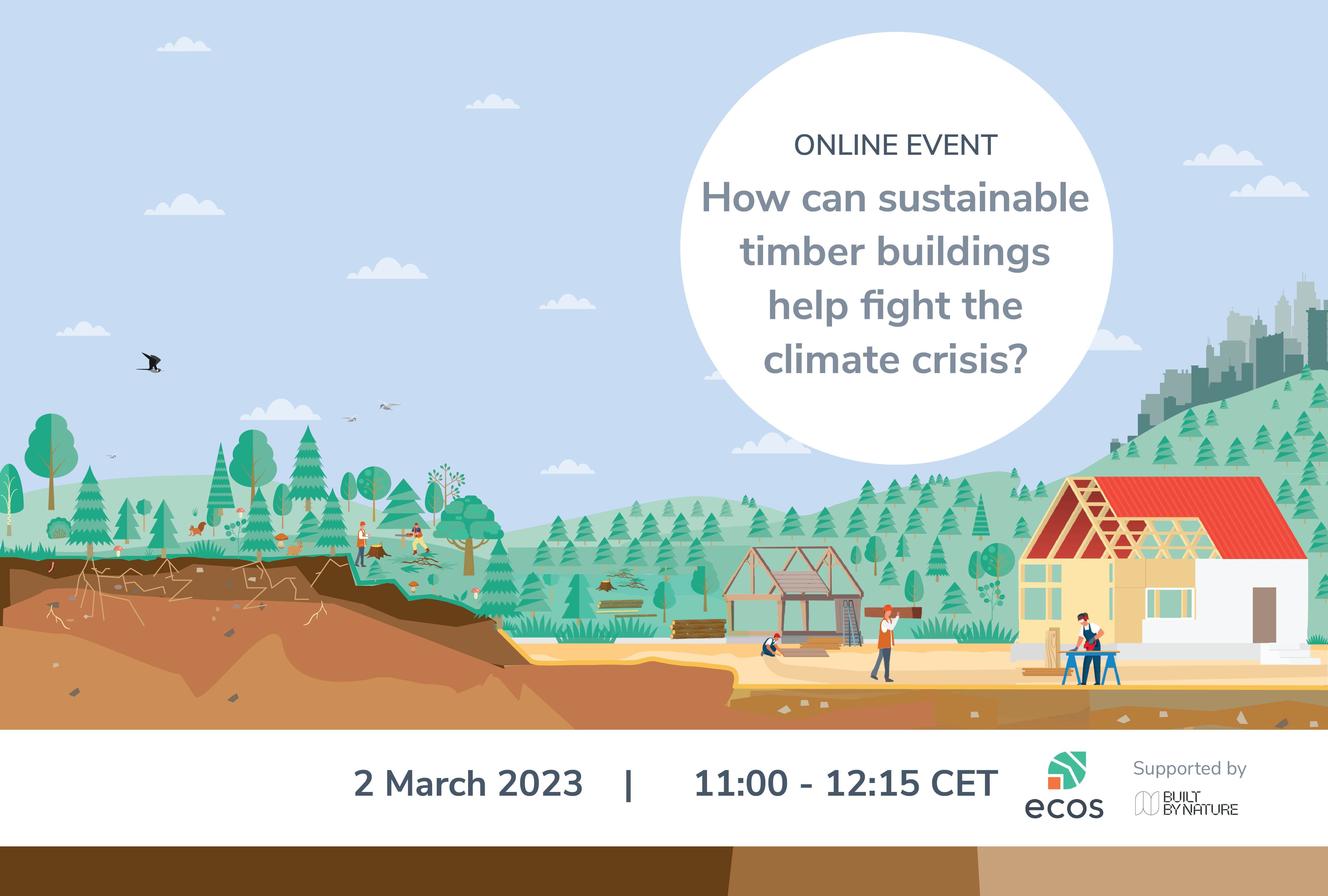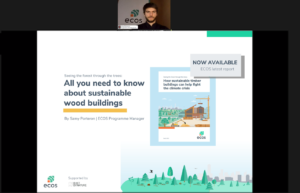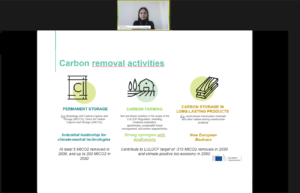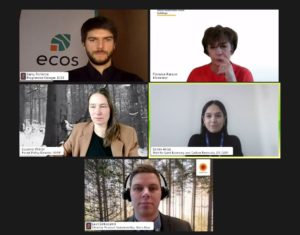Watch it again! Webinar: How can sustainable timber buildings help fight the climate crisis?
Read and watch the interactive discussion and key takeaways from the latest ECOS online event, "Seeing the forest through the trees: How sustainable timber buildings can help fight the climate crisis".

The building industry is a massive consumer of global resources and a major contributor to climate change. The good news is that the sector is on its way to becoming more sustainable. But do we have the right tools to build truly green? Watch our webinar and read the new report!
Ecological forestry and circular buildings are great contributors to climate mitigation. Are timber buildings part of the solution? Dive into our new report explaining how policy and standards can support the ecological functions of forests and decarbonise the building sector through a reasonable use of circular and sustainably-sourced timber.
How can wood buildings be truly green? How can policy measures and standards play a key role? Here are 3 top takeaways:
1️. Samy Porteron, Programme Manager from ECOS,  highlights that timber buildings are a promising solution to fight the environmental crisis if forests’ ecological limits are recognised, wood consumption patterns change, and ecological forestry leads the way.
highlights that timber buildings are a promising solution to fight the environmental crisis if forests’ ecological limits are recognised, wood consumption patterns change, and ecological forestry leads the way.
2️. Sevim Aktas, Policy Officer from DG CLIMA,  European Commission, confirms that emission reductions must come first, as well as residual emissions must be compensated with carbon removals. We need the combination of the two to reach climate neutrality.
European Commission, confirms that emission reductions must come first, as well as residual emissions must be compensated with carbon removals. We need the combination of the two to reach climate neutrality.
3️. Our panel discussion showed a common vision: For the green transition to become reality, we must zoom out to see the big picture – highlighting sustainable forestry and circular construction practices.
For the green transition to become reality, we must zoom out to see the big picture – highlighting sustainable forestry and circular construction practices.
Watch the full recording of the webinar here!
What the Q&A could not cover
ECOS webinar had a lot of interest: more than 130 people from more than 17 different EU and non-EU countries saw the forest through the trees.
Relevant questions came in, but we could not have the time to address them all. Samy Porteron, ECOS Programme Manager, has given answers to the most popular questions.
 How credible are forest certification schemes? How can consumers/builders know they are using “sustainable” timber in light of recent controversies?
How credible are forest certification schemes? How can consumers/builders know they are using “sustainable” timber in light of recent controversies?
Third-party certification plays an important role, but when certification fails to give assurance about the sustainability of products, confidence starts to erode.
A robust due diligence system is crucial for downstream sectors like construction to reliably source timber. Professional buyers who are serious about their impacts should prepare for this regulatory change by seeking to know their supply chain better by sourcing from forests located ideally near the construction site and pursuing ecological forestry.
It is time for certification to clear the air and play its role reliably, providing the necessary assurances that certified wood is genuinely green. More regulation is also needed: the EU Forest Strategy for 2030 has set the ambition to develop minimum standards for certification schemes. Now, the EU needs to start the action.
 What demands should policies and standards make regarding the supply of timber to construction projects in order to ensure timber construction supports ecological forestry, rather than deplete European forests?
What demands should policies and standards make regarding the supply of timber to construction projects in order to ensure timber construction supports ecological forestry, rather than deplete European forests?
1. Timber must be increasingly sourced from secondary sources.
Reused and recycled wood can come from existing buildings and infrastructure to make new constructions. This is the best way to avoid cutting another tree and therefore protect existing forests. Whereas a lifecycle assessment might show high benefits from using sustainably sourced timber, an even better result should be reflected in a reuse/recycling scenario.
2. We must end with the assumption in legislation and in standards that timber fulfils national legal requirements on logging, or which is certified as carbon neutral and ‘sustainable’.
The narrow focus on carbon has reduced sustainable forestry to a system which balances timber harvests with tree growth, thus ‘balancing’ the net carbon flows. This allows destructive clear cutting and monoculture plantations to be labelled sustainable. There is a need to recognise the importance of biodiversity, including tree species diversity – which ensures forest ecosystem functions and resilience to disturbances like fires and pests, among others.
3. Strong principles and criteria are needed to benchmark forestry practices against real ecological forest management.
Principles and criteria can serve as a benchmark for forestry practices and allow to set new requirements in forest legislation and standards. The European Commission’s work on guidelines for closer-to-nature forestry is one effort in that direction.

How can we take into account the forest system, soil carbon etc? Should these be included in the lifecycle analysis?
Knowledge of the environmental impacts of forest management practices is still poor, but assessments exist in the scientific literature. An ideal scenario is to include forest system impacts in the product or building lifecycle analysis. However, for this to be possible, the forestry sector needs to provide data and better methodologies linking the forest to the building.
Especially in times of doubt over the sustainability of certified wood products, transparency of the forestry sector’s impacts is becoming more important. Construction sector actors and lifecycle analysts should demand more information about the forestry practice of the timber sourced for buildings projects and question the carbon neutrality assumption.
We remind policymakers to make ecological forestry and circular buildings the primary point of the environmental discussions around buildings and forestry. Let’s see the forest through the trees!
Can you imagine a world without nature?#WorldWildlifeDay2023
We’re joining brands removing nature from the logos to highlight the nonsense of the #WorldWithoutNature
If we #RestoreNature, we tackle the climate crisis. At ECOS, we see the forest through the trees! @WildlifeDay pic.twitter.com/yedMHC9Gl1
— ECOS 🌳 (@ECOS_Standard) March 3, 2023

 By
By  By
By 
